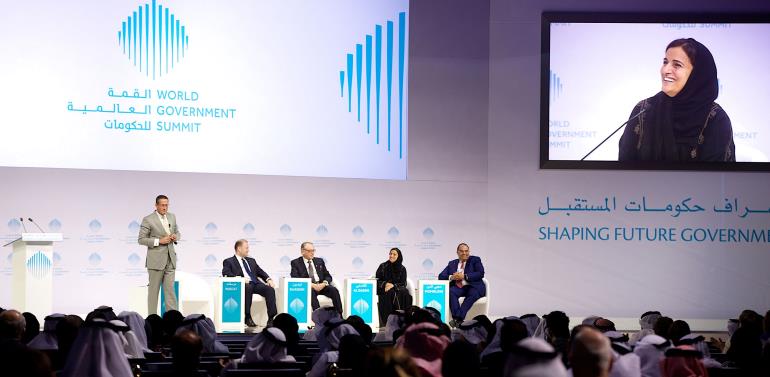International
Financing and Monitoring are Challenges facing 2030 UN Sustainable Development Goals: WGS 2016

Crunching numbers at an insightful panel discussion titled ‘The UN Sustainable Development Goals: Transforming our Global Vision into Reality’, eminent panelists noted that the world today is looking at 17 Sustainable Development Goals (SDGs), 169 sub-goals, more than 300 indicators and 15 years to reach the goals.
Participating in a round table at the World Government Summit 2016, the experts cautioned that while these are ambitious goals – eliminating poverty and hunger, tackling climate change and bringing about a just and peaceful global society, it would be meaningless if they were not transformed into reality.
The panelists – a senior minister of international cooperation and development from the UAE, a Prime Minister from Malta, a high ranking UN official and a World Bank representative sounded an optimistic note that the goals are achievable within the timeframe. However, they concurred the challenges will remain as governments at various levels, civil societies and NGOs, international organizations and multilateral agencies, and the private sector converge to move from aspiration to action.
Her Excellency Sheikha Lubna bint Khalid Al Qasimi, UAE Minister of International Cooperation and Development, said, “Close monitoring on a yearly basis is very, very crucial – to assess whether we are on track, whether we are skewing from the goals. The World Government Summit will be a venue where the progress on the SDGs will be monitored annually henceforth. I am optimistic that with technology and innovation as well as business models – disruptive and otherwise evolving every day, and the smart tools at our disposal it will be easier to achieve the SDGs.”
Saying she was an optimist and also a techie, Her Excellency Lubna Al Qasimi pointed out that with technology and innovation evolving every day, and the smart tools at disposal make it easier to deliver, “And it’s not just about technology, but also the business models that are evolving—disruptive and otherwise that make the goals feasible. Also, the 17 goals are not silos. Working on solutions on each feed into the other and help tackle several goals at the same time.”
Mahmoud Mohieldin, Senior Vice President for the 2030 Development Agenda, United Nations Relations and Partnerships at the World Bank, said, “The basics of reporting will need data, and the reality is that the luxury of data is missing for a good number of countries.”
On the question of who bears the responsibility of financing, Mohieldin categorically pronounced, “Every one that benefits. The private sector will have adequate incentives to partner with all other stakeholders to remain an active participant in working towards the implementation of the SDGs. It’s all about leveraging the money with the private sector, getting them to involve with the whole program of the SDGs.”
Mohieldin added that for the first three years, multilateral development banks have committed to an investment of $400 billion. He further noted that in pursuing the goals, it is important to be efficient in spending while investing in human capital, infrastructure and other vital sectors.
Furthermore, Mohieldin pointed to the role of government as a major challenge, “It’s not about the national government. There are four levels: local councils, regional and national governments and global governance.”
In contrast to the Millennium Development Goals (MDGs) which had a mixed outcome, Jan Eliasson, UN Deputy Secretary General, pointed out that the approach towards SDGs is a more “dynamic” one where the thinking has been horizontal rather than vertical, and will consequently generate enormous gains.
According to the Maltese Prime Minister Joseph Muscat the real challenge is in bringing about global social mobility. “The issue is how to devise aid to the poorer nations and peoples. Essentially that translates into a crucial question for every stakeholder to ponder on: how to create a global middle class, which doesn’t exist at the present time,” he pointed out.
While ministries and inter-ministerial committees of national, regional and local governments are expected to tackle and monitor the goals, as suggested by Eliasson, the power of social media cannot be overemphasized, according to Muscat.
“Social media,” Muscat said, “has created global awareness and global engagements and governments will have to change accordingly in ways to make the implementation of the SDGs successful. We do need to bring in the reforms internally.”
The World Government Summit has attracted more than 3,000 personalities from over 125 countries, and 125 speakers in over 70 sessions. The attendees include VIPs and senior experts from the public and private sectors globally, ministers, decision makers, CEOs, innovators, officials, experts, entrepreneurs, academics, and university students. A number of initiatives, reports and studies were being launched during the summit and throughout the year.
-

 News2 months ago
News2 months agoKitchenomiKs Secures Investment of US$3.2M Led by Jasoor Ventures
-

 Banking & Finance2 months ago
Banking & Finance2 months agoOman Arab Bank Highlights Its Ongoing Strategic Initiatives and Future Plans
-

 Energy2 months ago
Energy2 months agoWLGA Middle East LPG Summit & Expo 2025 to be held at OCEC on November 10 and 11
-

 Real Estate2 months ago
Real Estate2 months agoAl Mouj Muscat Unveils Azura Beach Residences Phase 2: A New Chapter in Waterfront Living
-

 Leaders Speak1 month ago
Leaders Speak1 month agoDhofar International Development and Investment Company: Driving Sustainable Growth and Strategic Synergies in Oman’s Investment Landscape
-

 Events1 month ago
Events1 month agoOER Corporate Excellence Awards 2025 Honours Entities and Innovations in Oman
-

 Economy1 month ago
Economy1 month agoMaal Card: What Oman’s New National Payment Card Means for Everyday Users
-

 OER Magazines2 months ago
OER Magazines2 months agoOER, October 25































You must be logged in to post a comment Login